Here’s A Tender Hungarian Beef Stew That Is Packed With Flavor!
Searching for an authentic beef stew recipe? This Hungarian beef stew – also known as Marhapörkölt, in Hungarian – is thick, hearty, and delicious!
The stew is made with stewing beef, tomato, bell pepper, and a number of spices (like paprika!) and makes for a really filling dinner dish.
Hungarian beef stew is best served with egg dumpling noodles called Nokedli in Hungarian or spaetzle in German. However, you can also enjoy this porkolt with boiled potatoes.
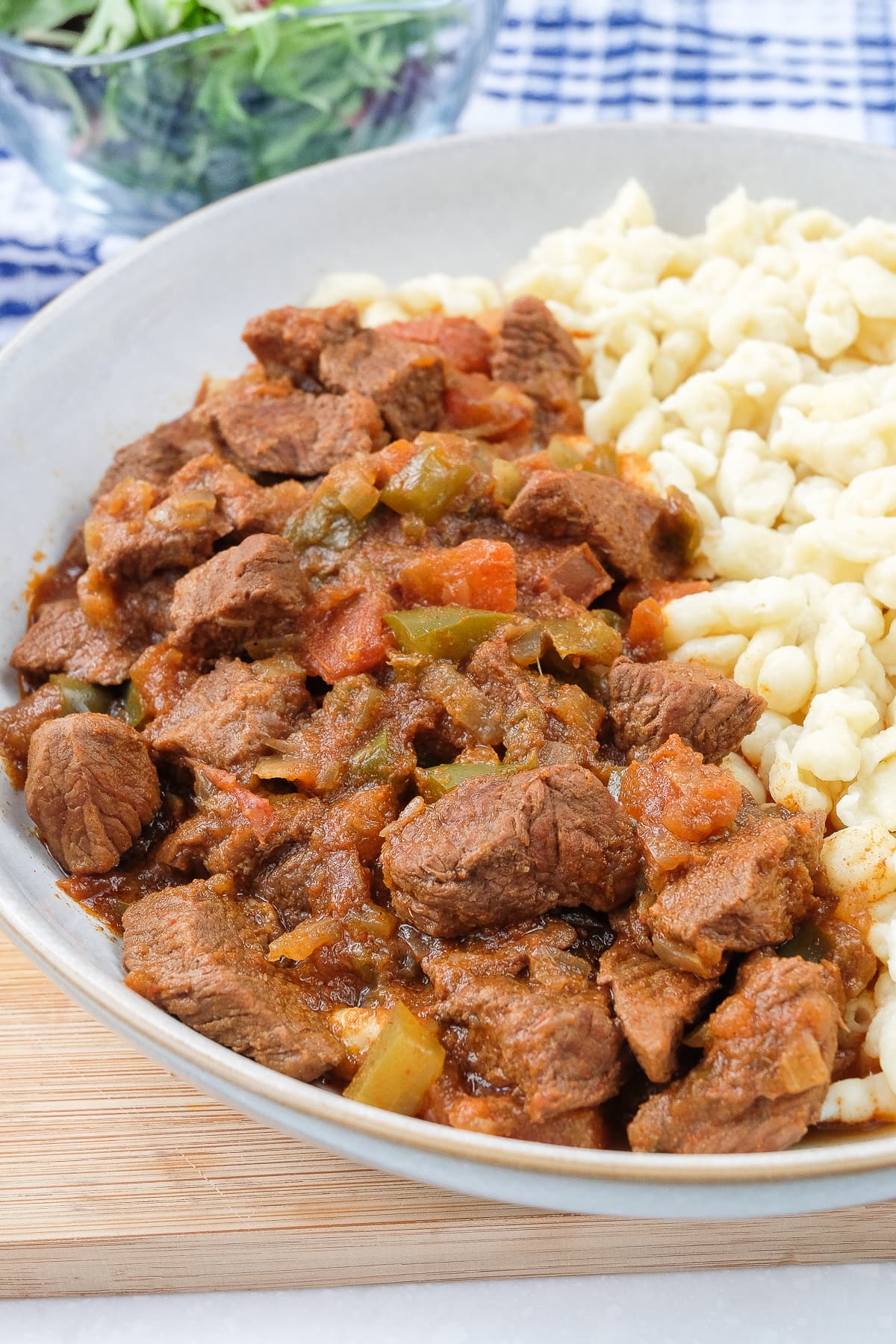
Hungarian Beef Stew vs. Goulash
To be fair, some people confuse this beef stew (marhapörkölt) with Hungarian goulash (gulyás).
Both have chunks of tender beef and both use paprika spice but when you compare more traditional recipes, that’s where the similarities end.
Marhapörkölt is a thickened stew that accompanies something hearty like Nokedli egg noodles.
Traditional gulyás is more of a soup – not a stew – with a much thinner broth. It’s made with potatoes in the soup and often with carrots as the only other vegetable.
Some people put red or green pepper in their goulash – which makes it more like this beef stew – but this isn’t standard in more authentic goulash recipes.
And not to complicate matters further but our German goulash recipe is actually more like this stew than Hungarian goulash. Sometimes the naming gets a little wild when recipes move between countries!
So, to summarize: Hungarian goulash is more of a soup. This Marhapörkölt is a thicker stew.
Recipe Tips/Substitutions
To make this beef stew recipe, be sure to consider these recipe tips and substitutions:
- Some people add red wine to this recipe. In this case, you’d be making vorosboros marhapörkölt. You would add the wine when you add the tomato and bell pepper and let it reduce for a bit. Then you’d add the water or broth – but less than indicated in the recipe card below.
- We usually use beef broth for our stew, but traditionally it is made with water. We like the added flavor from the broth, but the choice is yours.
- Ideally you use Hungarian paprika but regular sweet paprika will be fine if you can’t get your hand on Hungarian paprika. In Canada, you can often find it at the bulk store.
- We put green bell pepper in this recipe – if you want it a bit sweeter, you could also use red bell pepper or a mix of green and red.
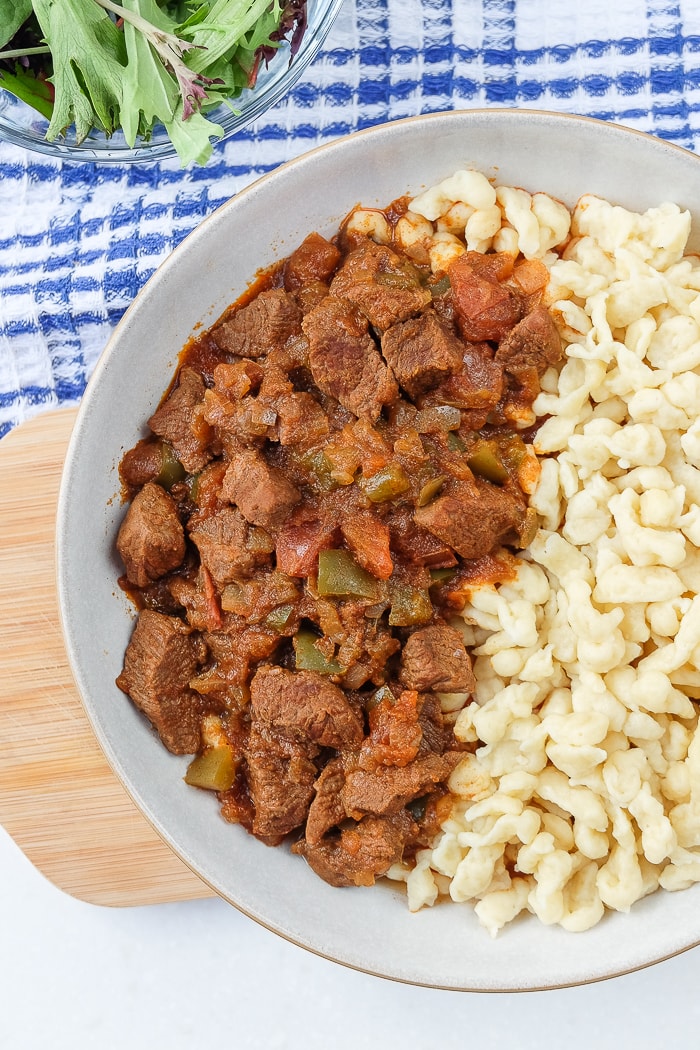
How to Make Hungarian Beef Stew – Step by Step Instructions
If you want to make marhapörkölt, you can find the recipe card with exact measurements at the bottom of this post.
For those wanting to follow along with visual step-by-step instructions, you can find the process photos in this section.
This way, if you have any questions along the way you can see exactly how we made ours!
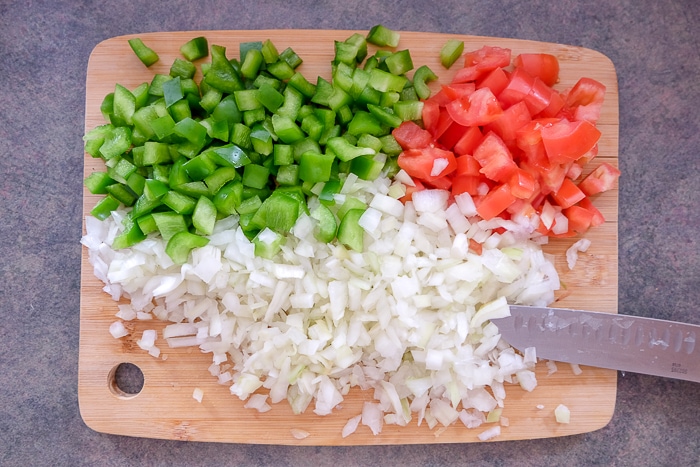
Peel the onion and finely chop it. Also, wash the green bell pepper, remove the seeds and cut it into small pieces. Wash and cut the tomato into small pieces as well.
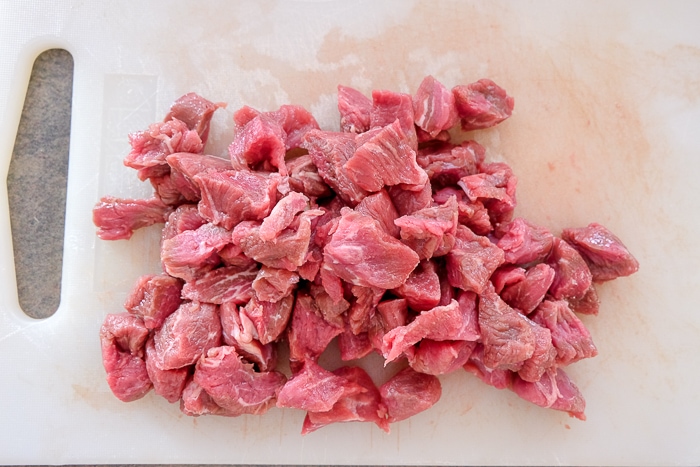
Cut the beef into approximately 1/2 inch cubes. You can also trim any excess fat if you want.
The pieces don’t have to be exactly the same size but try to get them somewhat even so that they’ll be tender at roughly the same time.
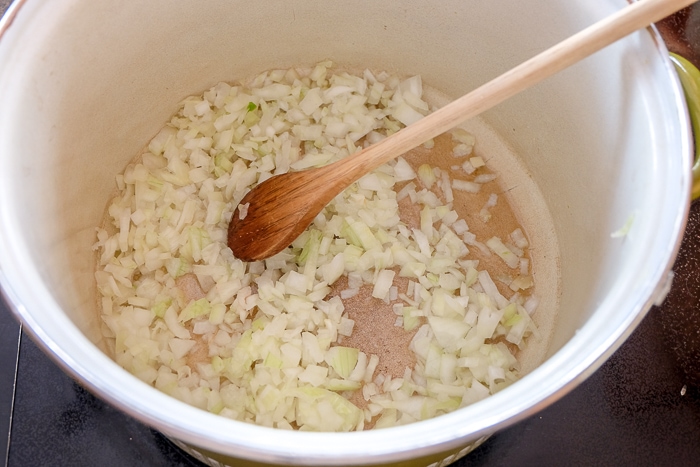
Heat oil in a medium-large pot and sauté the onion on medium heat until soft and translucent.
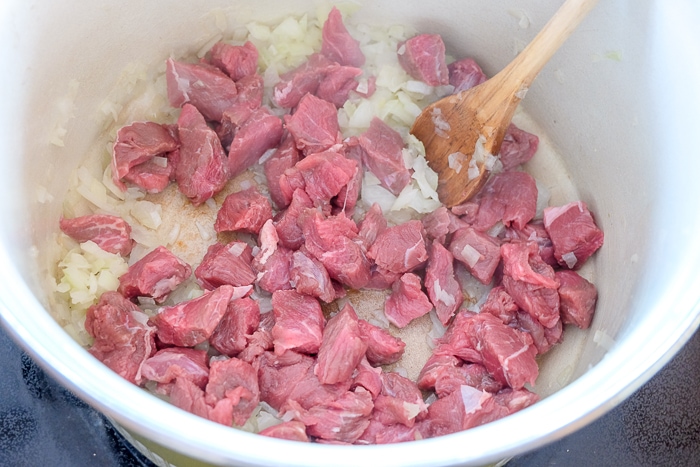
Turn up the heat slightly, add the meat, and brown it on all sides. Stir regularly.
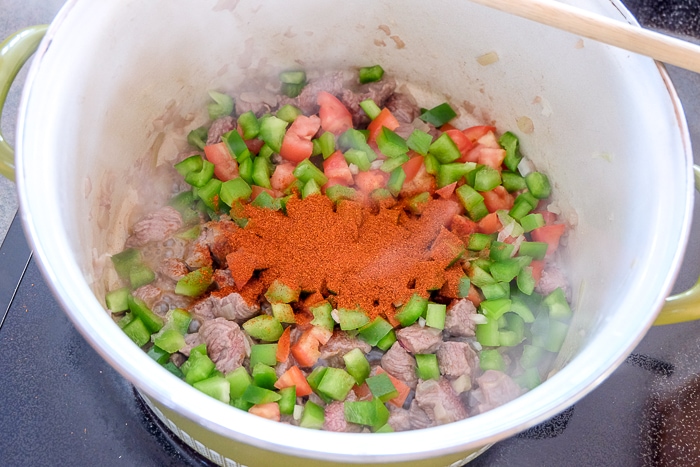
Turn down the heat again to medium. Add the tomato, bell pepper, paprika powder, and ground caraway to the pot.
At this stage, you can also add a crushed garlic clove if you want to add any. Stir everything to combine.
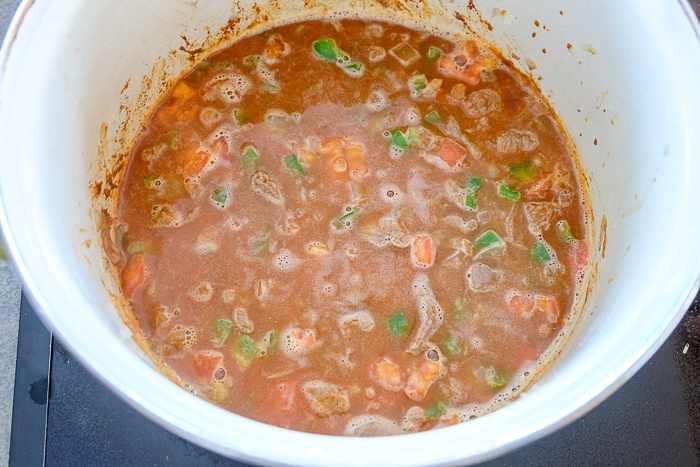
Now pour in enough liquid – either water or beef broth – until it just covers the contents in the pot.
In our case, that is approximately 2 cups of liquid but it might be slightly more or less in your case. Make sure to not add too much liquid.
Bring the stew to a light boil, then turn down the heat and let the stew simmer on low heat with the lid on for around 2 hours.
Make sure to stir occasionally and add more liquid if needed (we don’t usually need to do this).
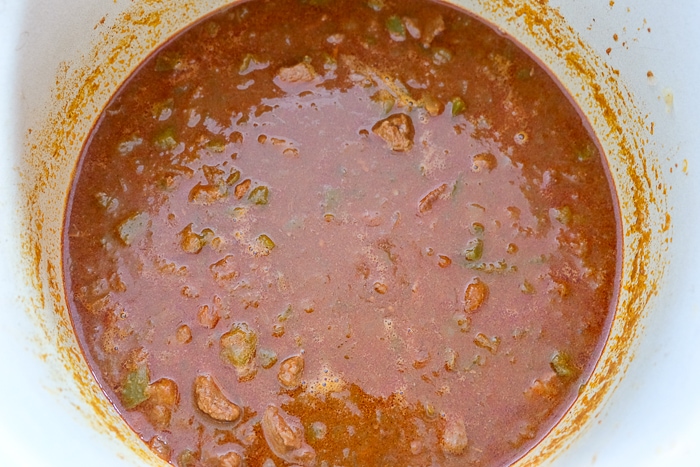
After two hours, taste the meat. If it is very tender, the stew is done – if not, let it simmer for a bit longer. When the meat is done, add salt and pepper to taste.
In case you would like the stew to be a bit thicker, let the stew simmer with the lid off for a few minutes so some liquid can evaporate.
Alternatively, you could also dissolve a little bit of cornstarch in some cold water and add it to the stew (we don’t usually do this though).
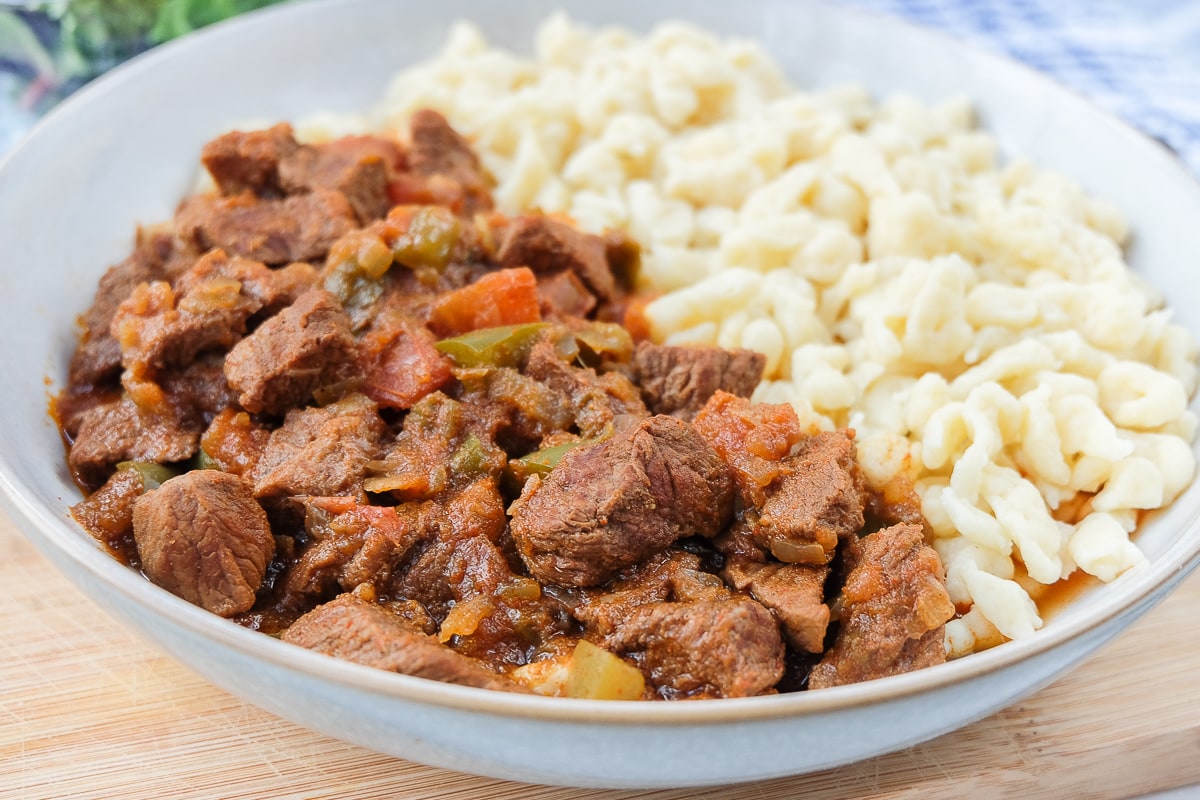
Serve the hot stew with nokedli/spaetzle or boiled potatoes. You can even chop up a bit of parsley if you like that as a garnish!
Storage Tips
Any leftover pörkölt should be kept in a sealed container and placed in the fridge once it has cooled.
Allowing it to sit overnight will even help the flavors to mingle. We’d recommend eating it within 2 days of cooking since it has meat in it.
To reheat, simply place the stew in a small pot and reheat it on the stove on medium-low heat. If it’s a little thick, you can add some water and stir regularly to avoid burning the bottom.
Alternatively, you can also reheat the stew in the microwave. You can also heat up any nokedli you have – or even make a new batch for this leftover stew!
Related Recipes
For more amazing Hungarian recipes, try out these classics and see what you think:
- Chicken Paprikash
- Lángos
- Hungarian Stuffed Peppers (Töltött Paprika)
- Hungarian Goulash
- Hungarian Cabbage Noodles (Káposztás Tészta)
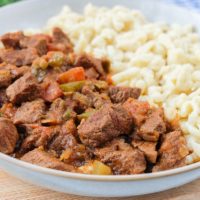
Hungarian Beef Stew (Marhapörkölt)
Ingredients
- 1 pound stewing beef
- 2 tablespoons vegetable oil
- 1 large onion
- 1 green bell pepper
- 1 tomato
- 1 garlic clove, crushed (optional)
- 2 tablespoons sweet paprika, ideally Hungarian paprika
- 1/2 teaspoon ground caraway
- 2 cups beef broth or water, approximately
- salt to taste
- pepper to taste
Instructions
- Peel the onion and finely chop it. Also, wash the green bell pepper, remove the seeds and cut it into small pieces. Wash and cut the tomato into small pieces as well.
- Cut the beef into approximately 1/2 inch cubes. You can also trim any excess fat if you want.
- Heat oil in a medium-large pot and sauté the onion on medium heat until soft and translucent. Turn up the heat slightly, add the meat, and fry it until all sides are browned. Stir regularly.
- Turn down the heat again to medium. Add the tomato, bell pepper, paprika powder, and ground caraway to the pot. At this stage, you can also add a crushed garlic clove if you want to add any. Stir everything to combine.
- Now pour in enough liquid – either water or beef broth – until it just covers the contents in the pot. In our case, that is approximately 2 cups of liquid but it might be slightly more or less in your case. Make sure to not add too much liquid.
- Bring the stew to a light boil, then turn down the heat and let the stew simmer on low heat with the lid on for around 2 hours. Make sure to stir occasionally and add more liquid if needed (we don’t usually need to do this).
- After two hours, taste the meat. If it is very tender, the stew is done – if not, let it simmer for a bit longer. When the meat is done, add salt and pepper to taste. In case you would like the stew to be a bit thicker, let the stew simmer with the lid off for a few minutes so some liquid can evaporate. Alternatively, you could also dissolve a little bit of cornstarch in some cold water and add it to the stew (we don’t usually do this though).
- Serve the hot stew with nokedli/spaetzle.
Notes
- If you don’t have Hungarian paprika, you can also use normal sweet paprika powder. And if you don’t have any ground caraway, you can add some ground cumin – just know that it will change the flavor a little bit and not be as authentic.
- Traditionally, this Hungarian beef stew is made with water. However, we often use beef broth instead for a little extra flavor.
Nutrition
This nutritional information has been estimated by an online nutrition calculator. It should only be seen as a rough calculation and not a replacement for professional dietary advice.
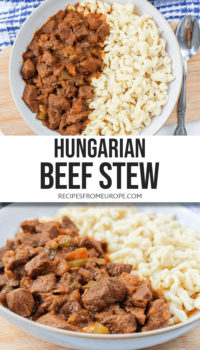
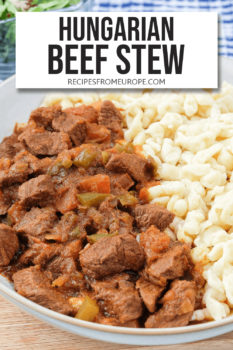

Bell peppers not really authentic.. we use TV paprika!
We also like to use TV paprika or cubanelle peppers when we can find them, but unfortunately, they are not always available where we live. To make this recipe as approachable as possible for many people, we often use green bell peppers as a substitute. This is something that Eric’s Hungarian mama often did as well. But that’s a good point, we’ll add a note so that people can keep an eye out when shopping for the ingredients for this recipe. /Lisa
I don’t see where you used a lot of vegetables as you said in your post. My friend that I met while living in Holland is Hungarian and this is the recipe she gave me.
4 1/2 lb beef shin or shoulder, or any tender part of the beef cut into 2 x 2 cm cubes ( The beef has been modified for the USA.
4 medium onions, chopped
4 cloves of garlic
2-4 carrots, diced
3 parsnips, diced, or 6-8 medium potatoes, Diced
2-3 celery ribs with leaves diced
3 medium tomatoes, peeled and chopped, and 1-2 tbs. tomato paste
2-fresh green peppers
2 tablespoons Hungarian paprika powder
2 teaspoons ground caraway seed
2 – 3 bay leaf
ground black pepper and salt according to taste
beef stock or water
Hi SCV,
That’s very interesting… I’ve never heard of potatoes being added to Marhapörkölt. In my circles, potatoes have always been strictly reserved for Goulash. We mentioned the vegetables in our recipe because I’ve also seen Marhapörkölt with hardly any veggies (basically just beef, onion, paprika, and broth). Goes to show how many variations there can be for a single recipe. Thanks for sharing your tips! /Eric